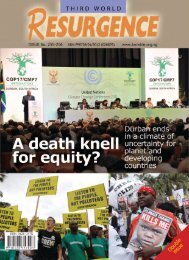Plantations, poverty and power - Critical Information Collective
Plantations, poverty and power - Critical Information Collective
Plantations, poverty and power - Critical Information Collective
You also want an ePaper? Increase the reach of your titles
YUMPU automatically turns print PDFs into web optimized ePapers that Google loves.
55<br />
explained that “association with APP would threaten the good will <strong>and</strong> faith invested in the name Forest<br />
Stewardship Council <strong>and</strong> the years of support <strong>and</strong> participation by companies that are truly committed to<br />
the pursuit of responsible forest management globally”. 271 Setting aside, for the moment, the fact that<br />
FSC has certified several industrial tree plantation companies which are clearly not “committed to the<br />
pursuit of responsible forest management”, FSC’s statement makes nonsense of Hermes’ arguments<br />
justifying its decision to support APP. Unfortunately, the damage is already done.<br />
APP China’s debt of about US$2.8 billion was restructured in November 2003. The debt-for-shares deal<br />
left Chinese state-owned banks as co-owners of APP China, but the largest shareholding is the Widjaja<br />
family, which had been buying up APP China bonds at a discount before the restructuring. APP owns<br />
only 0.1% of APP China meaning that APP China’s operations are out of reach of APP’s creditors. But<br />
APP China, APP <strong>and</strong> Sinar Mas are all still firmly under the control of the Widjaja family. 272<br />
APP China is exp<strong>and</strong>ing rapidly. The company’s projects in China include Gold East Paper Co. Ltd in<br />
Jiangsu, on the Yangtze River. By 2005, APP had invested US$1,823 million in its three paper machines<br />
at Gold East Paper. 273<br />
Another APP China project is Hainan Jinhai Pulp <strong>and</strong> Paper, the world’s largest single line pulp<br />
production facility. Pulp production started in November 2004. The mill produces 3,200 metric tonnes per<br />
day. Raw material comes from APP’s eucalyptus <strong>and</strong> acacia plantations, but the company is also buying<br />
wood chips, because the plantations are not sufficient to supply the mill. About 23 per cent of the mill’s<br />
wood is bought. 80 per cent of the pulp is sold to other APP mills, with the rest sold on the market. 274<br />
Yet another APP China project is Ningbo Asia Pulp <strong>and</strong> Paper, which produces paperboard. The mill runs<br />
on a mixture of recycled paper <strong>and</strong> virgin pulp. 275<br />
What was the money for<br />
One of the extraordinary aspects of the APP story is that the company managed to run up debts of<br />
US$13.9 billion. After all, the company only runs a h<strong>and</strong>ful of pulp <strong>and</strong> paper mills <strong>and</strong> related forestry<br />
operations. Until 2001, it made large profits – CIFOR’s researchers estimate profits of US$1.5 billion for<br />
the four main APP companies between 1993 <strong>and</strong> 1999. Yet by April 2001 according to APP, APP’s<br />
flagship pulp mill, Indah Kiat, had run up a debt of US$2.7 billion. 276<br />
Why did the banks never ask what all that money was actually for Indah Kiat managed to arrange loans<br />
271 “Forest Stewardship Council dissociates with Asia Pulp <strong>and</strong> Paper December 2007”, Forest Stewardship Council<br />
statement, December 2007. Available at: http://www.fsc-watch.org/archives/2008/01/10/FSC_dumps_Asia_Pulp_<br />
272 Jan Willem van Gelder (2005) “The financing of the Riau pulp producers Indah Kiat <strong>and</strong> RAPP, A research paper<br />
prepared for Jikalahari (Indonesia)”, Profundo, October 2005, page 2.<br />
273 “Bigger by the second”, RISI, 1 December 2005. http://www.risiinfo.com/contentgateway/pulp<strong>and</strong>paper/magazine/dbareaarchiveppmag2005001202.html<br />
274 “Bigger by the second”, RISI, 1 December 2005. http://www.risiinfo.com/contentgateway/pulp<strong>and</strong>paper/magazine/dbareaarchiveppmag2005001202.html<br />
275 “Bigger by the second”, RISI, 1 December 2005. http://www.risiinfo.com/contentgateway/pulp<strong>and</strong>paper/magazine/dbareaarchiveppmag2005001202.html<br />
276 Ed Matthew <strong>and</strong> Jan Willem van Gelder (2001) “Paper Tiger, Hidden Dragons. The responsibility of international<br />
financial institutions for Indonesian forest destruction, social conflict <strong>and</strong> the financial crisis of Asia Pulp & Paper”,<br />
Friends of the Earth - Engl<strong>and</strong>, Wales & Northern Irel<strong>and</strong>, May 2001, pages 18-19.















